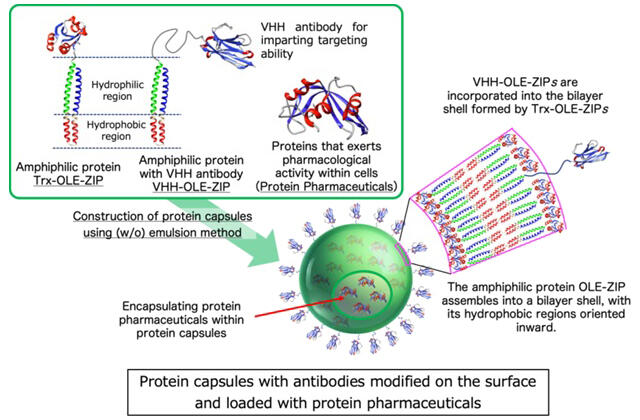A group led by Graduate Student Kousuke Takahashi (at the time of research) and Associate Professor Toshihisa Mizuno of Nagoya Institute of Technology, in collaboration with Nagoya City University, Tohoku University, and the University of Kitakyushu, announced that they succeeded in constructing protein capsules surface-modified with antibodies that can selectively deliver protein pharmaceuticals to target mammalian cells. This was achieved by containing the two-helix bundled protein designed by them. The capsules are expected to find application as drug delivery carriers. The results were published in the international journal RSC Pharmaceutics on August 1.

Provided by Nagoya Institute of Technology
The antibody drugs currently in use are not taken up by cells, so they function on their outer surface. Although antibody drugs are less prone to adverse effects, the discovery of drugs targeting intracellular biomolecules involved directly in biological activities has not been realized. Moreover, a small number of protein capsules have internal cavities measuring over 10 nanometers, highlighting the need for capsules with an internal space larger than 100 nanometers that can be filled with a greater quantity of pharmaceutical proteins.
In this study, the group designed a new two-helix bundled protein, in which two α-helices are bundled together as an amphiphilic protein with a hydrophobic surface on one side and a hydrophilic surface on the other side. They investigated the construction of protein capsules that meet the requirements of drug delivery carriers by creating an assembly using the emulsion method, similar to the formation of liposomes by phospholipids. The resulting protein capsules were confirmed to have a particle diameter larger than 100 nanometers but maintains sufficient structural stability. It was also confirmed that each capsule can be stably filled inside with 200 or more pharmaceutical protein molecules without denaturation or inactivation.
Furthermore, capsule surface modification with antibodies (IgG or VHH antibodies) specific to cancer cells as examples of target cells successfully imparted the property of being taken up only by the target cells to the capsules. The research group also succeeded in producing the desired pharmacological effects by the release of protein pharmaceuticals from the capsules to inside the cells. The antibody moiety of the developed protein capsules can be replaced for each target cell. Moreover, the internal space of the capsule can be filled with various protein pharmaceuticals. The results of this study are expected to lead to the development of drug delivery carriers in the form of protein capsule.
Mizuno said, "The development of biomacromolecules as drugs is expected to expand further in the future, as it has connections with regenerative medicine and many other areas. To promote such drug development, however, further advances in technology development to address the shortcomings and limitations of biopharmaceuticals are considered essential. I consider myself a chemist by trade, and I would like to continue to be involved in the development of drug delivery carriers reported in this study as well as in the technology development that can contribute to these areas."
Journal Information
Publication: RSC Pharmaceutics
Title: Target-selective cytosolic delivery of cargo proteins using the VHH-presented OLE-ZIP capsules
DOI: 10.1039/D4PM00069B
This article has been translated by JST with permission from The Science News Ltd. (https://sci-news.co.jp/). Unauthorized reproduction of the article and photographs is prohibited.




